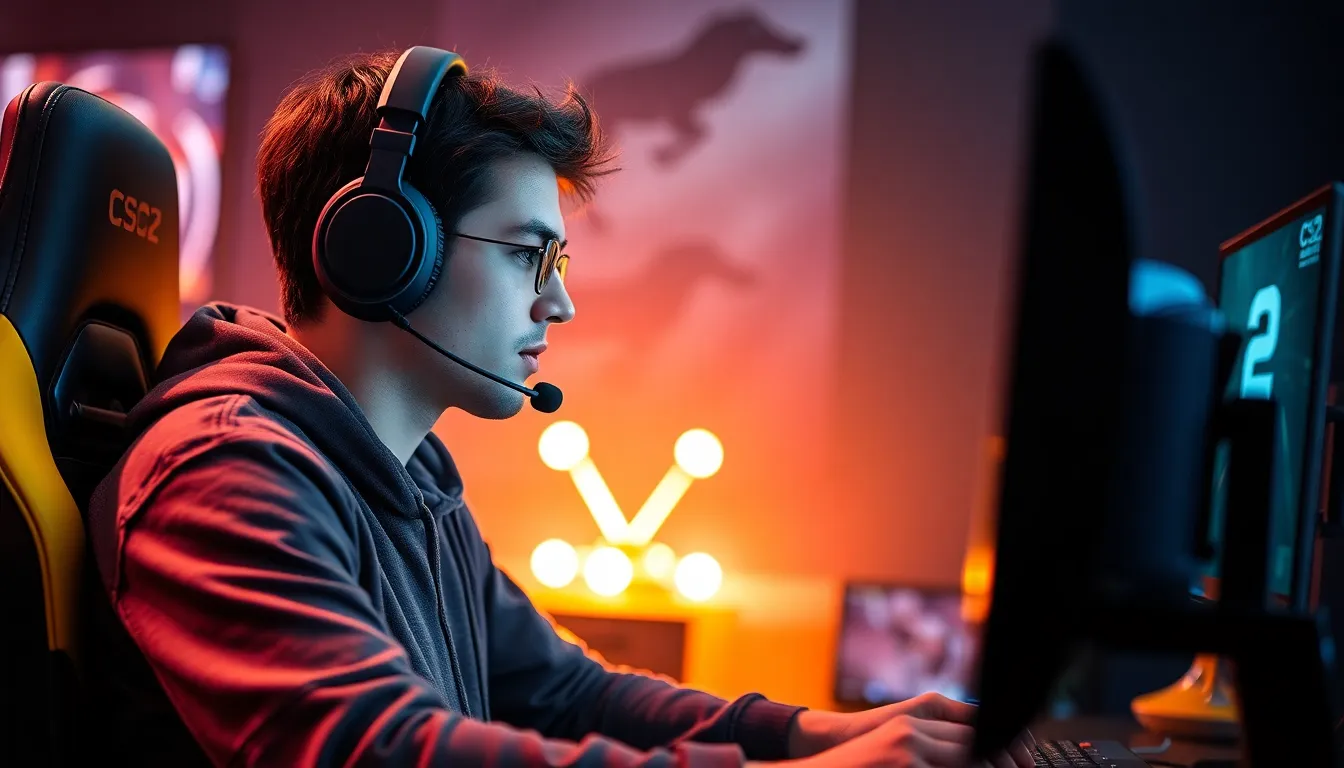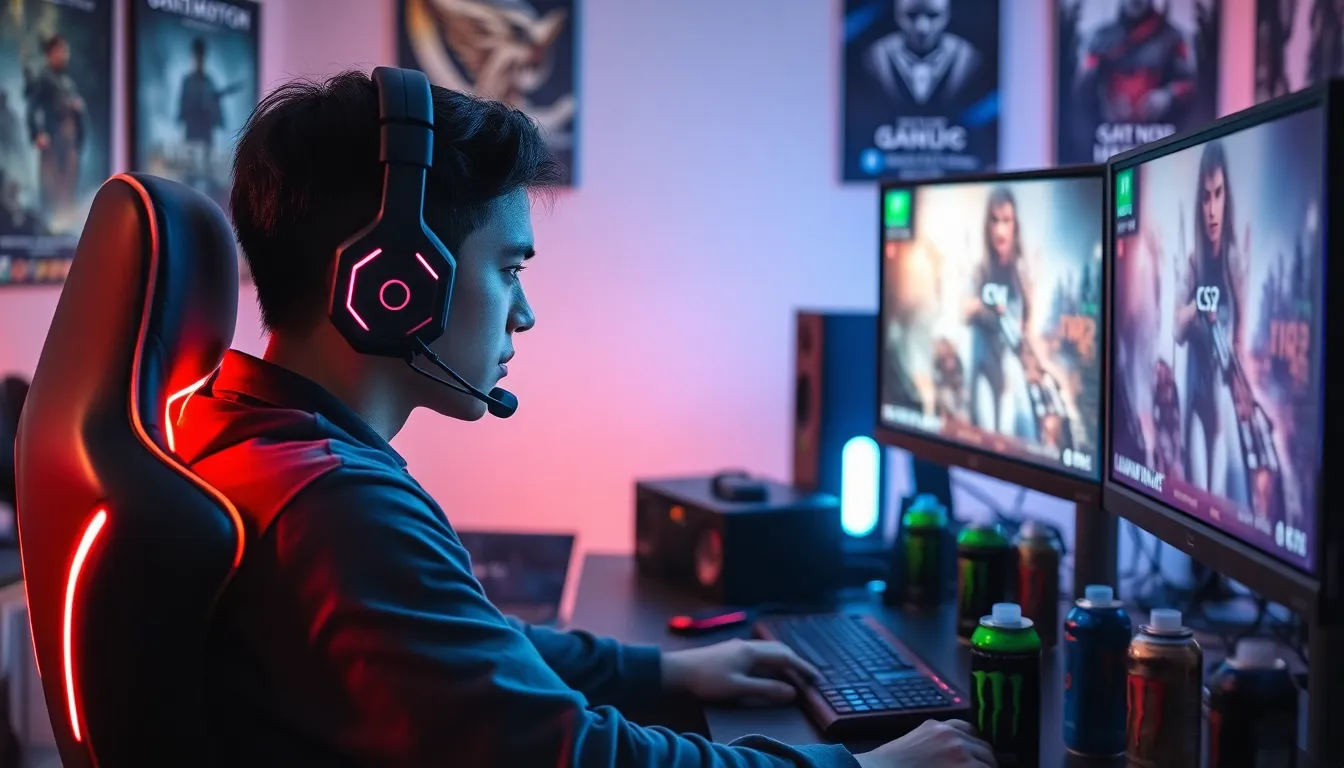In the world of competitive gaming, few things spark as much excitement as climbing the ranks in CS2. Picture this: you’re sweating bullets, dodging grenades, and your heart’s racing as you inch closer to that coveted rank. The CS2 ranked system isn’t just a ladder; it’s a thrilling journey filled with epic victories and the occasional facepalm moment when you misclick and end up staring at a wall.
Table of Contents
ToggleOverview of CS2 Ranked System
The CS2 ranked system provides players with a structured way to compete against others at a similar skill level. Players earn ranks based on performance, reflecting their abilities in various game modes. Ranks range from Silver to Global Elite, with each tier representing different skill levels.
Performance metrics play a crucial role in determining a player’s rank. Wins, kills, and overall contributions to the team significantly influence ranking progression. Each match contributes to a player’s matchmaking rating (MMR), which adjusts after each game depending on the match outcome and player performance.
Players experience different ranks within each competitive season, promoting a dynamic environment for skill development. Matchmaking aims to create balanced games, ensuring players face opponents of comparable skill. This system enhances the competitive atmosphere and fosters player growth.
Ranked matches offer additional challenges, including win streaks and rank resets, affecting a player’s journey through the ranks. Streaks of wins can boost ranks significantly while losses can lead to demotion, emphasizing the importance of consistent performance.
Communication and teamwork prove vital in ranked games. Heavily relying on collaboration, teams must effectively strategize and adapt during play. These elements contribute greatly to a player’s success within the competitive realm.
Understanding the intricacies of the CS2 ranked system enhances the gaming experience, empowering players to focus on skills needed for advancement. As they climb through the ranks, they encounter not only excitement but also the chance to showcase their abilities.
Key Features of CS2 Ranked System

The CS2 ranked system incorporates several essential features that enhance the competitive experience. Players engage in matches structured around their skill level, optimizing their growth and enjoyment.
Matchmaking Mechanics
Matchmaking relies on a player’s matchmaking rating (MMR). This system evaluates performance in each match. Players gain or lose MMR based on wins and losses, ensuring a fair competition environment. Individual contributions, such as kills and assists, also influence ratings. Communication skills and teamwork play crucial roles in determining match outcomes. Players facing opponents with similar skill sets ensure the challenge remains engaging and rewarding.
Ranking Tiers Explained
The ranked system includes multiple tiers ranging from Silver to Global Elite. Each tier represents a distinct skill level, allowing players to measure their progress effectively. Players typically start in lower ranks as they familiarize themselves with gameplay mechanics. Achieving higher ranks requires consistency and skill improvement. Promotions occur after players reach specific MMR thresholds, showcasing their dedication to growth. Rank resets at the beginning of each season refresh the competition, encouraging players to strive for new achievements while adapting to changes in the game mechanics.
Impact on Player Experience
The CS2 ranked system significantly shapes the player experience by fostering a competitive yet fair environment.
Competitive Integrity
Players engage with a robust matchmaking process that emphasizes fair competition. This system assesses individual performance while balancing skill levels among opponents. By adjusting match outcomes based on wins and losses, MMR reflects true player capabilities. Kills, assists, and overall contributions count towards rankings, promoting accountability. Every match instance holds value, reinforcing integrity within the competitive landscape. As a result, players develop trust in the ranking process, making their achievements feel more meaningful.
Player Skill Development
Skill development thrives within the CS2 ranked structure. Players often start in lower ranks to learn game mechanics and strategies. Progression demands consistency and improvement, pushing players to adapt and evolve. Regular exposure to different ranks challenges players, offering opportunities to hone specific skills. By engaging in dynamic matches, players identify strengths and areas for growth. The thrill of promotion comes after reaching set MMR thresholds, driving players to sharpen their abilities continually. Understanding the ranking system encourages focus and commitment to self-improvement, enhancing the overall experience.
Strategies for Success in CS2 Ranked
Success in CS2 ranked involves mastering multiple strategies. Players must focus on aspects like map knowledge and team communication for effective performance.
Map Knowledge
Understanding maps is fundamental in CS2. Players should familiarize themselves with layout, including choke points, bomb sites, and common hiding spots. Recognizing frequently used routes enables quick decision-making during intense matches. Knowledge of grenade throws improves tactical options, allowing players to gain advantages in engagements. Identifying advantageous positions helps in both offense and defense, enhancing overall gameplay. Observing how opponents move across various maps can also reveal patterns, aiding strategy adjustments. Prioritizing map knowledge often leads to smarter plays and higher win rates.
Team Communication
Effective communication distinguishes successful teams in CS2. Players must relay information clearly and promptly, using voice chat or in-game commands to communicate enemy positions or strategies. Establishing callouts for different map locations aids in quick responses, ensuring everyone stays informed. Adapting communication styles to match the team’s dynamics fosters collaboration and unity. Emphasizing calmness, even during chaotic moments, encourages better decision-making. Discussing tactical adjustments mid-game keeps teams flexible and ready to respond to opponents. Prioritizing team communication builds trust and enhances coordination, essential elements for achieving victory in ranked matches.
Common Issues and Critiques
Several challenges and critiques emerge within the CS2 ranked system. These issues can impact the overall player experience, influencing how individuals approach competitive gameplay.
Matchmaking Problems
Matchmaking inconsistencies often frustrate players. Many encounter mismatched teams, where players of varying skill levels compete against each other. Such discrepancies can lead to unbalanced matches and diminish the competitive element. Players frequently report that these issues detract from their enjoyment, as skill disparities can heavily influence match outcomes. With players aiming for improvement, the fairness of matchmaking remains crucial. Consistent observations highlight a need for adjustments in matchmaking algorithms to enhance the competitive balance.
Player Behavior
Toxic behavior negatively affects the CS2 ranked environment. Poor attitudes can stem from frustration during high-stakes games, leading to verbal harassment or unsportsmanlike conduct. This type of behavior fosters a hostile atmosphere, discouraging some players from participating in ranked matches. Individual actions significantly shape the gaming experience for others. Efforts to promote positive player behavior and implement stricter consequences for toxic actions can improve the overall atmosphere. Enhancing the community’s integrity requires commitment from both players and developers.
The CS2 ranked system offers an engaging platform for players to test their skills and climb the competitive ladder. With its structured ranking tiers and emphasis on performance, players can see tangible growth in their abilities. The thrill of competing against similarly skilled opponents drives players to improve and adapt.
While challenges like matchmaking inconsistencies and toxic behavior exist, the community’s commitment to fostering a positive environment can enhance the overall experience. By prioritizing teamwork and strategic communication, players can navigate the complexities of ranked matches more effectively. Embracing these elements not only leads to individual success but also contributes to a healthier gaming community.






